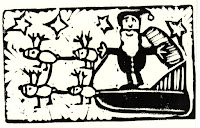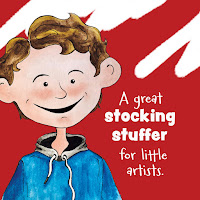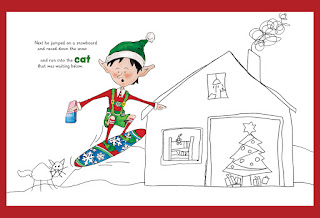 The idea for this book actually came from a Christmas card that my son Lukas, who was then only 7, made using linocut. It was a cute little image of Santa on his sleigh with four reindeer. I always loved this card. At the time it made me realize that no matter how hard I might try to draw something childlike, no one is better at making adorable childlike images than an actual child. Therefore, when I got the idea for An Elf Erased My Picture, I realized that I was not the best person to draw the boy's picture.
The idea for this book actually came from a Christmas card that my son Lukas, who was then only 7, made using linocut. It was a cute little image of Santa on his sleigh with four reindeer. I always loved this card. At the time it made me realize that no matter how hard I might try to draw something childlike, no one is better at making adorable childlike images than an actual child. Therefore, when I got the idea for An Elf Erased My Picture, I realized that I was not the best person to draw the boy's picture.My first thought was to have my son Lukas, who drew the original Christmas card I like so much, draw the boy's picture. However, he was no longer a little kid. Lukas is already 11 years old and 11 year old's like to draw things realistically. I also didn't want to ask him to draw as if he were younger. Luckily, I also had a younger child in the house. Max is only 8 and also loves to draw. So I asked Max if he could draw me a picture of Santa and his sleigh flying over a house. I showed him his brother's Christmas card to give him an idea of what I wanted. And man did Max deliver! His image was fantastic and just what I needed for my book. Because both brothers were actually involved in the inspiration and creation of this book, I added both their names to the dedication (Older brother Jonas already has a book dedicated to him, so he didn't mind).
My second challenge was time. I had a great idea, a boy's picture, and a text that I quickly spit out at my computer, but I still needed loads of editing and illustrations. Why don't I think of Christmas ideas sooner? I decided not to waste any time and I drew and painted all of the illustrations within a week. Then I got my mother on the phone, the best rhyming editor out there, to help me refine my text. Somehow we were able to get the whole thing put together in only three weeks. An Elf Erased My Picture was ready, just in time for the holidays.
 I think it makes a great gift for teachers as well as for little budding artists and Secret Santa. You can get it currently on Amazon or order from your favorite book sto
I think it makes a great gift for teachers as well as for little budding artists and Secret Santa. You can get it currently on Amazon or order from your favorite book sto
re. Here is the ISBN: 978-1-955698-02-03 and the link for more info: https://www.kelleydonner.com/an-elf-erased-my-picture































.JPG)
















